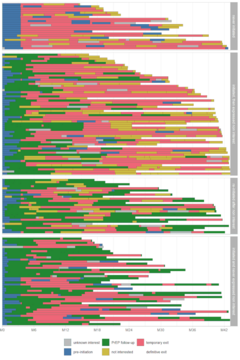Adoption of HIV preexposure prophylaxis (PrEP) among female sex workers (FSWs) in Côte d’Ivoire: complex trajectories and early adopters
Authors
Joseph Larmarange, Mélanie Plazy, Marcellin Nouaman, Evelyne Kissi, Rose-Marcelle Dedocoton, Patrick Coffie, Serge Eholié, Valentine Becquet
Abstract
BACKGROUND: The ANRS 12381 PRINCESSE project (11/2019-06/2023) enrolled 489 FSWs and implemented community-based sexual and reproductive health care, including PrEP, delivered through mobile clinics at prostitution sites in the San Pedro region. This presentation aims to describe PrEP trajectories and the factors associated with its use, focusing on “early adopters”.
METHODS: This analysis included 400 FSWs eligible for PrEP (HIV-negative, HBsAg-negative) enrolled up to December 2022 (>6 months of follow-up). Clinical records were analyzed to describe PrEP cascade, follow-up, and PrEP trajectories. A multivariable logistic regression identified factors associated with PrEP early adopters.
RESULTS: Although 98% of eligible FSWs were interested in PrEP, only 62% initiated PrEP, and 39% renewed it at least once.
Follow-up was very short (<6 months) for 48%, short (6-12 months) for 15%, seasonal (>12 months with a gap of 6 months between two visits) for 31%, and regular (>12 months with no gap) for 6%.
PrEP initiation was high among FSWs with regular (96%), seasonal (83%), or short (80%) follow-up, vs. 39% for those with very short follow-up. Among those who initiated, only 88% (regular), 70% (seasonal), 74% (short), and 35% (very short) renewed PrEP.
Among 148 FSWs with regular/seasonal follow-up, four PrEP trajectories were identified (cf. figure showing individual trajectories): 15% “never initiated” PrEP, 39% “initiated and were later not interested anymore”, 18% “re-initiated after non-interest”, and 28% “initiated and never expressed non-interest”, the last two groups being considered as “early adopters”. Factors associated with early PrEP adoption included the usual price of intercourse with clients <1500 FCFA (aOR=2.4 [1.2-4.8]) and working in brothels (aOR=3.2 [1.6-6.6]).
CONCLUSIONS: In PRINCESSE, loss-to-follow-up and seasonality of risks limited PrEP adoption. FSWs who were more precarious and less mobile became early adopters of this new prevention tool and could serve as potential ambassadors for promoting its uptake.
